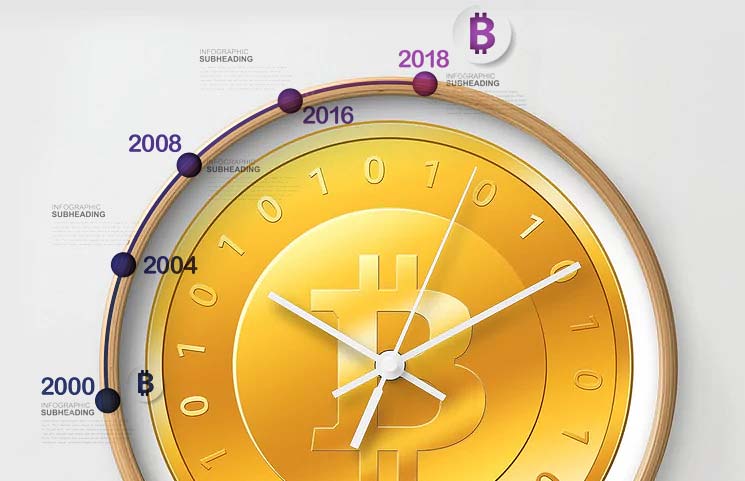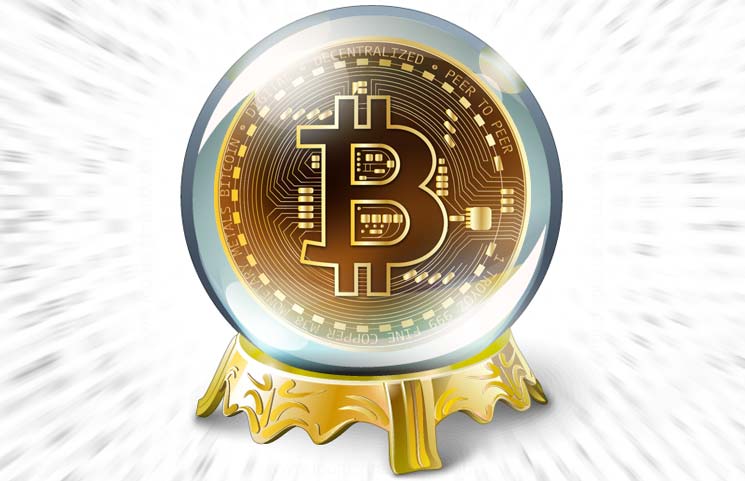Bitcoin Guides
Top 7 Online Methods & Sites To Buy Bitcoin with a Credit Card

7 Methods To Buy Bitcoin with a Credit Card
It was seems like it was eons ago when Bitcoin was just a strange idea used by criminals in the dark web. It was a time when society considered Bitcoin with equal measures of mistrust and skepticism. However, things have changed for Bitcoin now, and 2018 is set to become the biggest it has ever become in its life-cycle.
This year will be important because Bitcoin has made leaps and bounds for the wider market. The price of bitcoin jumped 7 times its value since the start of 2017, and has managed to overcome some of its biggest problems yet. One of those problems was the face-off between Chinese regulators, which happened near the end or 2017. Speculators and users of the coin and now flocking back to Bitcoin and the whole market has enjoyed gains in its value that can be traced to enthusiastic investors looking for the next Bitcoin.
As Bitcoin becomes rapidly adopted by the mainstream, people from all walks of life and small business owners are looking for ways to buy the virtual currency. The good news is that buying Bitcoin has become easier than ever before. No longer do customers have to go through a huge amount of hassle and inconvenience. The unprecedented demand for Bitcoin has bought in fast and easy ways for people to buy Bitcoin, with credit card purchase the best way for many.
As Bitcoin transactions cannot be reversed once they are finalized, there have been fears by exchanges for people to buy these coins through credit cards. Most platforms have been put off the idea as information can be too easily stolen and misused by bad actors without the consent of their owners. This can trigger expensive charge backs when the original owners submit complaints with their banks and reedit card companies. Yet this is slowly changing, as the demand for Bitcoin and other alternatives have put the pressure on exchanges to innovate safer buying processes for Bitcoin using these plastic cards.
Table Of Contents
Below, you’ll find some of the best ways of buying Bitcoin with your credit or debit card, arranged by platform.
Coin Mama
Coin Mama was the original platform to allow customers to buy Bitcoin with credit cards. Coin Mama is based in the United States, and claim to have always customized its business towards making easier payment options for its customers. This this before the widespread use of credit cards.
One of the first exchanges to hit the ground in providing flexible payment means for Bitcoin is CoinMama. This US based exchange has always tailored its business towards providing the easier payment option for their customers. Even before their adoption of credit and debit cards, CoinMama was one of the very few exchanges that allowed their users to make a Bitcoin purchase through Western Union. And now that they have adopted credit and debit cards, buying has even become easier.
CoinMama has a good reputation in the market with a track record of exceeding its customers’ expectations, making it one of the most reputable places online use your debit or credit card for buying cryptocurrencies.
We’d even go as far as to say that CoinMama is a specialist in the field of buying cryptos with a debit or credit card. Their service offering can be a great choice for buyers due to the amount of coins you can purchase. The only downside of CoinMama is that there’s a limit of $150 worth of Bitcoin for each trade if your account is unverified, while verified customers can buy up to $20,000 worth of Bitcoin each month.
How to use CoinMama for buying cryptocurrencies
Simply navigate to the CoinMama homepage and you’ll be met with the option of selecting your desired payment method. Go to the Bitcoin column and select how many Bitcoins you’d like to buy in either USD or BTC. Choose from the packages offered e.g (0.1 BTC, 0.5 BTC).
Click the Buy Bitcoins button and this will send you to a sign up page where you can fill out your personal information, and you’ll need to upload an identity document that has your picture on it, such as passport or drivers licence.
The good thing is that verifying your identity with Coinmama is straightforward as it takes less than an hour or so. Once you have confirmed your details you can then make a purchase by visiting the payment section.
For your bitcoin purchase to be made quickly, you can use the Credit Card payment option using Simplex. If you have an unverified account, you can still buy coins using the Money Gram option. Money Gram lets you get hold of Bitcoins with your credit card without needing to verify your account. This option is only available to US residents.
Once you pay for you coins, you will need to put some balance into your Bitcoin wallet address, so make sure you have one prepared before you reach that stage, and click the proceed to payment button.
On the next page you will be asked to fill a form with all your credit card details through the Simplex portal that gets paid to Coinmama. Once the transaction has been processed you should almost instantly get the bitcoins in your wallet.
On the next page you will fill a form with all your credit card details through the Simplex portal to CoinMama. Once all checks out you will almost immediately receive your Bitcoins in your wallet.
Coinbase
Coinbase is one of the most popular exchanges for buying and selling cryptocurrencies, so no list about using your credit card to buy Bitcoin would be complete without its mention. Coinbase is one of the most widely-used exchanges in the world, and comes with advanced security features. Everything about it has won the respect of the entire community.
Coinbase claims to hold all of its stores of Bitcoin and other cryptocurrencies in a 100% offline vault, which means that the coins can never be hacked from the outside. Coin base’s staff is required to go and tap the stores for the daily transactions to be made on the Coinbase platform.
Coinbase is popular as it accommodates a greater number of countries than other exchanges based in the US. At the present, it accepts payment for Bitcoin for thirty three countries and more are due to be released as Coinbase gains popularity. A registered person on the site can make a buy of up to $150 each week and once 100% verified, that number gets pumped to $1000 per week through the use of credit cards,
So, for those who are completely new to the world of cryptocurrencies and are looking for an easy way to get started, Coinbase is a highly recommended option due to how easy it is for customers to make a purchase. Coinbase charges a fee of 3.75% for each transaction.
How to Buy Using Coinbase
Go to the Coinbase site and click on the sign up button to start registration.
Fill in all of your relevant details to make your account.
Once that account is verified, log into your account and navigate to the settings page on your dashboard.
Click on the Payment Methods and then Add Payment Method. From there, you can select between adding credit or debit cards.
You’ll then be taken to a page where you can supply your credit card details. Don’t forget those numbers on the back (CCV).
If your purchase is confirmed, you’ll then need to go back to the site’s buy and sell page, which is where you can start your purchase process for your new Bitcoins.
Once your request goes through, you will then get your Bitcoin in a new Coinbase wallet. Always remember to transfer your coins made from any exchange once you are finished. This is what keeps your coins safe.
If you are required to buy more Bitcoin than the limits, then you will be asked to upload a government Id and connect that to your credit card. You’ll be charged an additional 3.75% processing fee to use the system. However, if it’s a debit card, then no charge will be incurred.
Bitpanda
If you live in or around Europe and you are looking for one of the cheapest ways to buy Bitcoin then Bitpanda is for you. Bitpanda is a startup in Austria, and became a business back in 2014. Bitpanda offers a variety of different payment options such as Neteller, Skrill, SEPA, and of course it lets you pay via your favorite credit card brands.
Unlike other platforms, the charges with Bitpanda are not fiat, so this means that you can determine how much you get charged. However, on the whole, the fees for Bitpanda are in the middle of the road, which is due to the number of chargeback modes they support.
Using your credit card is actually cheaper than using other options like Skrill, which means that BitPanda will charge you around 2% for any transaction. This is in sharp contrast to the 3.77% for most other payment methods.
Bitpanda is cutting edge when it comes to making its verification process straightforward d and easy, with the amount of Bitcoin you are able to buy depending on what verification level you decide. The lowest verification level will ask for your phone number and let you buy 50 Euros worth of Bitcoin at once, and 600 Euros total a month.
While for fully-verified accounts that have been vetted with government IDs, users will see a big rise in their daily purchase volumes. A verified account can buy up to 2500 Euros of Bitcoin every 24 hours. This accumulates to a cap of 75,000 in a single month for credit cards to verify the purchase.
Many people find Bitpanda easy to use and is simple to navigate by those who have even a rudimentary know-how of the buying and selling process for cryptocurrencies. Additionally, the platform has plenty of positive to feedback to read over from its customer base. This is impressive for a company that has been in business for just 3 years. Their reputation is better than other companies who have been in the market for much longer.
How to buy Bitcoin using Bitpanda
Start by visiting the Bitpanda site using your browser and then click the Get started button.
It will then ask you to verify your identity. This involves making sure that you are using your own email and not someone else. Fill out your email address here and click the Captcha box.
Once verification is complete, you can then create a new account through filling in your other details.
Now navigate to the account settings page and add your payment option.
Select the Credit Card option and fill out the relevant details that need to be confirmed. This can be done through an SMS code, or an automated call to authenticate your phone number.
Once the stage is complete, you are now ready to start buying Bitcoins at any point you wish. Just hop on to your account and click the “Buy Bitcoins” button at the top of your window.
Then select how many coins you’d like to purchase.
CEXIO
CEXIO is a broker for Bitcoin that started in cloud mining back in 2013. Since then, it has transformed itself into being one of the most sought after exchanges in the world for offering simple payment solutions for its end users. As one of the oldest sites in the business, CEX.IO has plenty of experience and has amassed half a million users on its platform.
As CEX.IO opens itself to the risk of risky payment methods for things like credit cards, the platform goes the extra mile to verify each of their customer’s identities before they are allowed to make transactions. But, once that verification process is over, it’s then relatively simple to get started with buying and selling all manner of coins, with those coins being sent almost instantly.
And unlike other exchanges, CEX.IO live up to its end of the deal by providing exactly what it agreed to for Bitcoin transactions. For example if a user wanted to buy 3 Bitcoins at a price of $500 per coin, that’s exactly what they’d get in return – notwithstanding the volatility of the trading market.
Also, it has one of the most generous volumes for transactions out of any exchange. Non-verified users can buy as much as $500 worth of Bitcoins in a single day and up to $2,000 in a single month. While verified accounts can buy and sell up to $100,000 in a month with daily volumes capped at $10,000. If that’s not enough, you can always opt for the unlimited transaction model, which can be sourced through buying a Verified plus or Corporate account.
On the other hand, one of the biggest problems for CEX.IO is that it charges an inordinate amount of fees and transaction charges. CEX.IO can take as much as 7% of the total amount you pay in transaction fees. This means that if you were to buy $1,000 worth of Bitcoin, the amount you’d get back would only be $930.
How to Buy on CEX.IO
Register your email address on the sign up page, verify your email, and then submit all your up to date personal information.
Once you email address has been confirmed, you can then add a payment method for your account settings. Select the credit card option.
Submit your credit card details along with the address you registered the card to.
If your address confirms, you can then go and make your first purchase on the platform, through inserting the wallet address that you’d like the coins sent to.
Bitsamp
Bitstamp was one of the first exchanges to make an impact on the cryptocurrency business, and is a registered company in Luxembourg. It’s quite popular with bitcoin buyers who can’t buy from other exchanges, as Bitsamp runs an international service. Bitstamp has a great reputation within the sphere of cryptocurrency exchanges as it has more experience than most other sites, especially with the behavior of its users.
As Bitstamp accepts customers from every country, the registration and verification process for Bitstamp takes a bit of effort to get through. Verifying each account takes time, especially as Bitstamp allows for higher trading volumes.
Bitstamp accepts numerous payment options and processes its card and debit card payments through a different service known as Simplex, which is the same service that CoinMama uses.
How to Buy On Bitsamp
Go to the accounts registration page for, and then fill out the form with your email address.
You’ll need a username and password to be sent to your email, which then is required to be activated to buy and sell coins.
Go back into your Bitstamp site ten visit the login page. Once you’re there, input the username and password they sent to login to your account.
You can then change the password to something of your choice, which will then take you to the verification step.
Fill in the form with the required information. Once you’re finished with that, you’ll then need to wait for Bitstamp to notify you via email once your account is verified.
Once that’s done, you can include your credit card details and then make your purchases.
247Exchange
247Exchange is yet another means of buying Bitcoins using your credit card if you are not situated in the United States or a European country. 247Exchange is a top-rated exchange when it comes to support for its customer network, and its user interface is rather simple and can be easily understood and navigated – even to those who are new to the cryptocurrency industry.
However, 247Exchange can be a bit difficult to use when it comes to truly verifying your credit card information. Your cards are usually charged a small amount of which you must verify before you’re able to start buying. This charge sometimes gets hooked along the way, and means you may not get the required alert unless you try it several times.
How to buy with 247Exchange
Register your personal details on the site along with your email address.
Verify that email address using the link that will be sent in an email.
Choose your payment method as Credit Card.
Input your Credit Card number and other details. Once those credit card details goes through, you’ll be charged a small amount which you’ll need to verify with the alert you’ll get from your credit card company or banking platform.
Once you get setup and verified, you can then make your first purchase that will be sent to your wallet instantly.
Localbitcoins
It’s easy to overlook that there is more than one way to buy bitcoins. You can actually buy and sells bitcoins on the secondary market, facilitated by services such like LocalBitcoins. As an added bonus, LocalBitcoins provides one of the most diverse ways of buying Bitcoins via credit card payments.
When you use the Local Bitcoins service, you are not dealing with a single entity or exchange service with a large headquarters. Instead, you are dealing with other crypto traders who are just like yourself; people who have a lot of bitcoin to trade and who may have their own payment terms. Sellers on LocalBitcoins accept a diverse range of methods for payment such as wire transfers, PayPal, bank deposits, and even gift cards.
LocalBitcoins could offer you a variety of prices to pick from, as each vendor sets their own fees. It also provides other benefits such as anonymous buying as vendors typically will not demand to see your personal info, which is unlike exchanges. And unlike exchanges, some vendors will ask for you to make a purchase for goods worth the Bitcoins and ask to have them sent to their addresses.
How to Buy Using Local Bitcoins
Register on the LocalBitcoins website as a buyer.
One the main page, fill out what’s called a “buy order” and clearly state the amount of Bitcoin that you’d like to buy, your means of payment and location.
Wait a bit for the Bitcoin vendors to find you and accept your terms.
Otherwise, you can browse through the list of vendors and select the vendors that match your requirements.
Finally, contact one and get down to business.
Buying Bitcoin with Credit Card Summary
So, as one can see, there is a multitude of different ways to buy and trade Bitcoins. What method you decide to go with will depend on your preferences and what you’re looking to get from the platform.
However, the best thing to do for starters to weigh up the pros and cons of each platform and what they can offer you.
It should also be mentioned that your main concern should be the security of your information, credit card details, and the bitcoins you buy. Always be very careful when entering your payment information and card data.
Remember: if you have any suspicions about the service you choose, you need stop. As the full responsibility of your actions squarely rests on your shoulders.
The best way to get started is by talking about the above services with people who know you know as it can be hard, if not impossible, to get any money back from these platforms, especially if you were ripped off.
Bitcoin Guides
Bitcoin Price History: Bitcoin (BTC) Crypto Market Timeline – MyBitcoin

Bitcoin Reaches its 5 Month Peak – April 23rd, 2019 – $5,599
Bitcoin has managed to shrug off the initial losses from last month and managed to reach a major high point of $5,598 as of April the 23rd. This has been one of the first times that Bitcoin managed to successfully rise above the $5,500 price point clocked in November of last year. This marks a five month record high for Bitcoin.
Bitcoin Pushes Above the $5,000 Marker – 10th of April 2019: $5,412
Bitcoin has, as of this point in Early April, managed to undertake an unprecedented surge in its price point. Putting this in perspective, it managed to push above the $4,200 mark and rapidly blasting past $5,000 within 48 hours. After it had begun the month at $4,152, the price of Bitcoin had managed to sit on a strong $5,412 by this date in April.
Bitcoin Manages to Conclude March at Above the $4,000 Margin – March 31st: $4,152
Throughout the course of March, Bitcoin had managed to enjoy a white hot streak of performance after it endured a sluggish if optimistic beginning to the year. Successfully ending March on a more positive margin of above $4,100.
Bitcoin Maintains a 10 Percent Incremental Rise Month Over Month – February 28th, 2019: $3,867
Bitcoin had commenced February just below $3,500 before ending February 10 percent higher than it began. Meaning that, by the end of February, it had closed at approximately $3,867.
CBOE Officially Withdraws its Bitcoin ETF Proposal Before Resubmitting – January 31st, 2019: $3,461
CBOE, in partnership with VanEck and SolidX, officially withdrew its proposal to create and launch a Bitcoin Exchange Traded Fund as of late January, in light of fears regarding the prolonged government shutdown which begun in the United States causing the cancellation of its proposal anyway.
By the end of January (31st to be exact), the CBOE had officially resubmitted its Bitcoin ETF. There are those that believe that this VanEck and SolidX Bitcoin ETF has the highest likelihood of being the very first BTC ETF that will be approved by the Securities and Exchange Commission.
Bitcoin Starts the Year Below the $4,000 Mark on January 1st, 2019: $3,773
Bitcoin made a start of 2019 underneath the previous $4,000 high level. Starting off at the price point of $3,773 and a total market cap of $66 billion. The month was a negative one for Bitcoin, dropping to a low of $3,468 by the close of January.
Bitcoin Mining Becomes Unprofitable – December 3rd, 2018: $3,469
According to research from Morgan Stanley in 2018, the profitability of mining ceased at any value below $8,600. By this point from the past few years, difficulty, in conjunction with the chronic non-profitability of Bitcoin conspired to hammer the value of Bitcoin.
For the second time in its history, Mining difficulty fell by 15 percent in order to accommodate the depreciation in value and support miners.
Bitcoin Cash Officially Commits Hard Fork – Creating ABC and Satoshi's Vision (SV): November 15th, 2018: $4,275
After a series of disagreements and very incendiary arguments among core developers operating within Bitcoin Cash, officially completed a hard fork. Thus resulting in the creation Of Bitcoin Cash ABC and Bitcoin SV. This then resulted in a hash war which would last several months with Bitcoin Cash ABC emerging as the dominant currency.
It was during this same span of time that the price of each of these tokens violently fluctuated, having the additional knock-on effect of hitting Bitcoin prices, causing it to drop to $4,275.
Bitcoin's Whitepaper Celebrates its Tenth Birthday, October 31st, 2018: $6,415
The Bitcoin community officially celebrated its tenth birthday since the launch of Bitcoin's whitepaper back in 2007. It was over this span of time that bitcoin's price managed to steadily grow over the days prior to this anniversary, resulting in a total of 5 percent in growth over this week.
Fidelity Officially Launches its own Crypto Trading Solution For Institutional Investors: October 15th, 2018: $6,497
While Bitcoin has sustained a bad number of weeks, Fidelity provided a desperately needed shot of financial B12 to the market with the announcement of Fidelity Digital Assets – which operates as an enterprise level custodial service for financial entities that are interested in investing in cryptocurrencies. Because of this new entrant, Bitcoin's price rose sharply over the weeks.
Cryptocurrency Exchange, Zaif Falls Victim to a $60 Million Hack, September 18th, 2018: $6,539
Zaif, a cryptocurrency exchange based in Japan officially lost approximately $60 million worth of various crypto assets during a hack. This, in turn, had a knock-on effect of pushing Bitcoin prices into recession, reaching below $6,000 before rallying.
Goldman Sachs Announces it is Dropping its Plans to Launch a Bitcoin Based Trading Desk – September 5th, 2018
While the company had begun and sustained the exploration of launching a Bitcoin trading platform for the majority of 2018, Goldman Sachs officially announced that it would be dropping its plans to launch a desk. For many investors, they have blamed the ongoing bear market for the diminishing interest from Goldman Sachs. Because of this announcement, Bitcoin prices continued to fall.
SEC announces Decision to Delay on Bitcoin ETF Ruling – August 7th, 2018: $6,366
What came off as a surprise decision for some in the Crypto trading world, the Securities and Exchange Commission announced that it would be exercising its right to delay its decision on several proposed Bitcoin ETFs that had since been proposed to the regulatory agencies.
As a result of this news, the value of Bitcoin continued to plummet, with investors enduring a pessimistic climate that no ETF would never be approved.
Intercontinental Exchange Officially Announced the Launch of Bakkt: August 3rd, 2018: $6,337
The parent company of the internationally known New York Stock Exchange – the Intercontinental Exchange [ICE] among a number of other exchanges announced the launch of a Cryptocurrency startup known as Bakkt. Backed by the likes of Microsoft, Starbucks and a number of other big corporate names.
Bakkt had the underlying goal of appealing to institutional investors through a legitimate market for Bitcoin.
The Securities And Exchange Commission Rejects the Gemini Bitcoin ETF Proposal by the Winklevoss Twins for the Second Time – July 26th, 2018: $7,275
The Security and Exchange Commission officially rejects an ETF proposal from the company owned by the Winklevoss Twins. This is the second time that the proposal was rejected by the SEC, citing that the markets were still in a perpetual immaturity, making them a non-conducive environment for an Exchange Traded Fund.
The SEC expressed a particular concerned regarding the price manipulation. After a few days of good momentum from the market, Bitcoin's value depreciated.
Blackrock Announced Intent to Explore Cryptocurrency and Bitcoin Related Fund, July 16th, 2018: $8,227
It was made widely public through the news online that one of the world's largest investment fund managers – Blackrock – had officially set up a working group in order to examine the prospect of a crypto and / or Bitcoin related fund. The Chief Executive Officer of Blackrock would go on to confirm the report during an interview which took place days after with Reuters.
While Blackrock has yet to launch any kind of fund of this kind, the value of Bitcoin managed to rise significantly thanks to this news.
Facebook Announced Broader Ban on Cryptocurrency Related Adverts: June 26th, 2018: $6,656
Facebook announced that it would be reversing its previous ban on cryptocurrency related advertising which was initially announced back during the beginning of the year. During this time, Bitcoin's value managed to rise ahead of this news, with investors theorizing that the bearish trend for Bitcoin was over.
Cryptocurrency Exchange – Bithumb – Was Hacked, June 20th, 2018: $5,928
Operating within South Korea, Bithumb was officially hacked, resulting in the loss of over $31 million worth of various crypto assets. In light of this news, Bitcoin decreased significantly over this month, making the second quarter of this year one of the worst on record.
The US Commodities Futures Trading Commission Files Subpoenas Against Four Cryptocurrency Exchanges, June 11th, 2018: $6,709
The United States Commodities and Futures Trading Commission officially filed and submitted Four subpoenas to the international crypto exchanges – Bitstamp, Kraken, ItBit and Coinbase. The subpoenas demanded a broader explanation about potential market manipulation.
It was in the aftermath of these legal proceedings, it was revealed that the majority of these crypto exchanges were, in fact, engaged in a high level of wash trading along with other manipulative strategies. These include a number of more well known, reputable and regulated crypto exchanges like Coinbase.
The United States Justice Department Officially Launched Criminal Probe Into the Allegations of Bitcoin Price Manipulation, May 24th, 2018: $7,609
It was made official that the United States Justice Department has launched a new criminal probe into whether or not cryptocurrency exchanges were participating in the manipulation of crypto prices through the application of underhanded tactics like spoofing, Pump and Dump methods and wash orders.
Prosecutors in South Korea Raided UpBit, May 11th, 2018: $8,372
Known as one of the largest cryptocurrency exchanges in operation within South Korea, Upbit was subject to a raid by legal prosecutors under suspicions that it was conducting fraud to some capacity.
The overall cost of Bitcoin fell by 5.5 percent to $8,511 in light of this news before falling further downwards to hit lower support of $8,372 as of the end of the week.
Goldman Sachs Begins exploration of Launching of Bitcoin Trading Solution, May 2nd, 2018: $8,729
It was reported by the New York Times that Goldman Sachs, the International financial company was exploring the prospect of launching a bitcoin trading platform. The creation of this service would allow for clients of Goldman Sachs to conduct trades of Bitcoin from within their already operational investment accounts.
Twitter Launches Ban on Cryptocurrency Advertisements, March 26th, 2018: $7,127
Following in the wake of decisions made by both Facebook and Google, Twitter went on to announce that it will be imposing a ban on Cryptocurrency related and Initial Coin Offering Advertisements. The only way that it would remove this ban is once it clarifies its policies.
Google Announces Ban on Cryptocurrency Advertisements, March 14th, 2018: $8,570
Google became the second major multinational company to impose a ban on cryptocurrency advertisements and Ads for Initial Coin Offerings. Google also provided a full range of crypto specific terms within its broader ‘bad advertisements' policy.
The Securities and Exchange Commission Requires new and Existing Cryptocurrency Exchanges to Register, March 7th, 2018: $8,344
It was made clear through the reiteration that crypto exchanges are under legal obligation to register with the Securities and Exchange Commission if the intention to do business and operate within the United States.
Facebook Implements new Ban on Cryptocurrency Adverts, January 31st, 2018: $8,211
The Social Media giant, Facebook, officially unveiled its new ban against cryptocurrency and Initial Coin Offerings within the platform. This decision was made after a large volume of complaints regarding ICO fraud, malware due to Phishing sites using crypto as incentive, and a range of other scams.
Coincheck Announces Freeze of any Withdrawals From the Platform After Falling Victim to Largest Hack of Bitcoin on Record, January 26th, 2018: $8,775
One of the largest known crypto exchanges operating within Japan officially halted all withdrawals after being subject to the single largest hack on record. Attackers had managed to vanish with approximately 123 million dollars worth of XRP, and 500 million NEM.
These losses totaled more than 600 million dollars stolen. The crypto attack against Coincheck is the single largest in the history of cryptocurrencies.
80 percent of the Total Supply of Bitcoin Has Been Mined, January 13th, 2018: $8,776
Spanning a lifespan of less than a decade by this point since the genesis block of BTC was mined, nearly 80 percent of all known Bitcoin has since been mined.
Priced undergo Decline Thanks to Regulatory Proceedings Within Korea, January 8th, 2018: $10,685
Within the space of a night, CoinMarketCap suddenly removed price forecasts and analytics related to cryptocurrency exchanges operating within South Korea, causing a dramatic fall in Bitcoin sales, panicking investors as a result.
Peter Thiel, Silicon Valley Venture Capitalist and Investor is Buying Up Large Numbers of Bitcoin, According to Reports, January 2nd, 2018: $13,870
Reports disclosed at this time demonstrate that the Silicon Valley based Venture Capitalist, Peter Thiel has allegedly bought millions of dollars worth of Bitcoin as of the beginning of this year, according to major news sources. According to further reports, his already existing Founder Fund was allegedly valued at hundreds of millions of dollars by the beginning of 2018.
South Korea Muses Over a Wider Shut Down of Cryptocurrency Exchanges in the Country, December 28th, 2017: $17,163.38
After a surge of very positive momentum for Bitcoin and its investors, Regulatory and financial authorities in South Korea worked to dampen further enthusiasm by suggesting a new raft of financial regulations against the country's cryptocurrency exchanges. Regulatory justify these actions as being in light of concerns about the drastic overheating of crypto positions: “cryptocurrency speculation has been irrationally overheated in Korea”.
Bitcoin Manages to Reach its all Time High Value, December 18th, 2017: $19,783
Today marks the day that Bitcoin manages to reach an all time high value point at approximately $19,783. This is a record peak that has not been matched or surpassed to date.
CBOE Introduces Bitcoin Futures Contracts, December 11th, 2017: $17,010.53
The announcement by CBOE regarding the launch of its Bitcoin futures contracts caused the price of Cryptocurrencies to surge dramatically upwards, reaching an all time high value during Mid December. This massive surge was so dramatic that it resulted in the temporary halt to crypto trading in order to try and calm down the futures markets. CBOE in the meantime, announced the launch of its own futures contract after its competitor – CME – launched its own futures product.
Segregated Witness Proposal (SegWit2x) Officially Cancelled, November 8th, 2017: $7,844
Bitcoin core developers officially put into schedule its own upgrade package for November 16th. This was known as Segregated Witness 2x (SegWit2x). This was followed by a sudden falling away of support for the range of proposals, leading it to be cancelled.
CME Introduces and Launches its own Bitcoin Futures Contract, October 31st, 2017: $7,255
The CME, otherwise known as the Chicago Mercantile Exchange announced its intention to launch a Bitcoin Futures contract by the . final quarter of 2017. This represented one of the first major institutions to become interested in . the world of cryptocurrencies, especially Bitcoin as a viable investment tool.
It was in light of this news that Bitcoin begun the month surging to a record high of $6,601, meaning that it also managed to hit an all time high market cap of approximately $110 billion. In light of this announcement by the Chicago Mercantile Exchange, its rival, the Chicago Board of Exchange also announced that it would be launching of a Bitcoin futures contract of its own shortly after.
Bitcoin Manages to Break Past the $5,000 Value Marker for the First Time, October 13th, 2017: $5,943
While the Cryptocurrency begun the year at a price point of $966, Bitcoin has been continuing on its strong performance, hitting an all time high value of $5,243. Successfully breaking through its $5,000 value point for the first time.
Chinese Bitcoin Crypto Exchanges Undergo Massive Shutdown, September 15th, 2017: $3,714
All China based cryptocurrency exchanges undergo widespread shut down as ordered by Chinese authorities. This immediately created wider spread panic across the entire industry, sending the price of Bitcoin downward.
JP Morgan, Chase's CEO – Jamie Dimon condemns Bitcoin as a ‘Fraud', September 12th, 2017: $3,807
The highly outspoken Co-founder and CEO of JP Morgan Chase and Co – Jamie Dimon made his opinions about Bitcoin pretty clear to his employees and investors across the world when he said that he would fire any employees that proved “stupid enough to buy bitcoin”.
Along with these comments about Bitcoin, he would go on to call Bitcoin a fraud of a currency, arguing that, for investors would not “end well' for those getting themselves deep into crypto. The price of Bitcoin was nowhere near the kind of negative reactions that it had felt in other situations, with many investors merely shrugging off that CEO's statements.
China Officially Bans Initial Coin Offerings, September 3rd, 2017: $4,224
With the emergence of ICO in popularity over the span of 2017, China took the initiative in taking a hard-line approach towards this cryptocurrency based method of fundraising. A broad range of regulators eventually took approach of leveraging a widespread ban on Chinese companies, preventing them from raising money through the use of this method.
Bitcoin Officially Splits Into Two Currencies – Bitcoin and Bitcoin Cash Through Hard Fork, August 1st, 2017: $3,384
With its early emergence over the course of 2017, there were some major and turbulent challenges over the middle of the summer that year when it came to the matter of scalability within Bitcoin. These teams of developers finally decided upon an official split, thus creating Bitcoin and Bitcoin Cash, with each of these cryptocurrencies taking a differing approach towards the matter of scalability.
Japan Officially Recognizes Bitcoin as a Legal Currency, April 1st, 2017: $1,215.69
After months of deliberation by Japanese authorities, the country officially recognized Bitcoin as a legal method of payment according to the country's legislature. It is within this newly developed regulatory scheme, the Bitcoin exchanges within the country would need to operate in conjunction to newly introduced regulatory practices, such as anti money laundering policies and Know Your Customer rules.
SEC Denies the Wiklevoss Bitcoin Exchange Traded Fund – March 10th, 2017: $1,038
It was made official by the US Securities and Exchange Commission that the Bitcoin Exchange Traded Fund (ETF) application set forward by the Winklevoss twins was rejected, citing that the immaturity and lack of stability of the cryptocurrency market meant that an ETF was not possible.
Bitcoin manages to break through the $1,000 For the First Time in Nearly Three Years, January 3rd, 2017: $807
After a period of rallying over the course of 2016, Bitcoin had managed to break the $1,000 price point for the first time in the matter of years.
Stock Markets Plummet as a Result of Donald Trump's Shock Election Victory – Bitcoin Prices Rise, November 9th 2016: $749
In a dramatic and startling victory for the Republican Party, the now president Donald Trump officially defeated Democratic hopeful Hillary Clinton. The announcement caused massive shocks across global stock markets. US Markets, for example fell by approximately 1 percent, Japan's own Nikkei fell by 5.4 percent, Hong Kong's Hang Seng slid by 2.1 percent.
Meanwhile, Gold increased by approximately 3 percent while Bitcoin enjoyed a significant rise in contrast to major global markets, increasing by 5 percent. Traders and institutional investors also began to see the intrinstic value of using Bitcoin as a hedge against broader market movements.
Bitfinex Loses 72 Million Dollars in Cyber Attack, August 2nd, 2016 – $591
The Cryptocurrency exchange, Bitfinex made the announcement that it had officially lost more than 120,000 of its customers Bitcoins due to a catastrophic security breach of the system. This equaled a total of 72 million dollars worth of Bitcoin lost at the time, Overall, the value of Bitcoin managed to decrease by over 20 percent, causing the price to recede to $480 after the announcement by Bitfinex.
The hack had a broader scope of repercussions within the Bitcoin community as a whole, and Bitfinex had contributed to a broader decline of prices over the last month. This was all before the Bitfinex announcement was made. This indicated that there were parties within Bitfinex that had prior knowledge that this hack was going to take place.
Bitcoin Halves for the Second Time – July 9th, 2016: $674
This date commemorates the second time in the history of Bitcoin that the Bitcoin block reward was halved from 25 Bitcoin per block to 12.5
Craig Wright Declares That he is Satoshi Nakamoto, May 2nd, 2016: $454
Within a blog post on his website, the Australian Craig Wright announced that he . is the true developer behind Bitcoin – Satoshi Nakamoto. As a kind of evidence fro this, he provided a private key signature demonstrating that he had control over the walled off Bitcoin that had been stored back in 2009 /2010.
This same evidence was subsequently debunked by the community within the same day. This same claim by Wright is continually debated and attacked to this day.
Steam Accepts Bitcoin Payments, April 27th, 2016: $461
The gaming platform developed by Valve, Steam announced that it would go on to accept Bitcoin as a medium of payment for a range of video games and digital content on the platform. In order to achieve this, Valve announced that it will be putting to use the Crypto Payments solution – Bitpay in order to provide this service for users.
OpenBazaar Launches and becomes one of the first Decentralized Marketplaces, April 4th, 2016: $426
OpenBazaar launches and becomes the very first digital and decentralized marketplace. It's objective is to create an open peer to peer market which removes the need for any kind of middlemen, fees or restrictions on digital trade. The company would go on to announce that they had successfully received over 1 million dollars worth of seed funding from major nationally active venture capital firms such as Union Square Ventures as well as Andreessen Horowitz
Segregated Witness Was Proposed by a Range of Bitcoin Core Developers and Miners, February 21st, 2016:
Members of the Bitcoin community descended upon Hong Kong in order to discuss Bitcoin and its future goals. One of the proposals designed to redress the challenges related to scaling was known as Segregated Witness otherwise known as SegWit, which was proposed during the body of the meeting in order to deal with ongoing congestion as it related to transactions. The group had finally agreed to scale Bitcoin in order to make it into an international solution for payments.
Wired Reports That Craig Wright is Satoshi Nakamoto, December 8th, 2015: $461
Wired officially published an article at this time claiming that Dr Craig Wright was officially the developer of Bitcoin – Stoshi Nakamoto – arguing that either the Australian businessman was either Nakamoto or a ‘brilliant hoaxer'.
Gwern Branwen had cited a series of emails, deleted blog posts along with a wide range of leaked court documents within the article in order to provide evidence that Wright is Nakamoto.
In order to further attempt to substantiate his own claim to being Nakamoto, Wright would go on to provide proof to a small pool of researchers that he was, in fact, Nakamoto. Even if this was the case, the proof is still very much disrupted by the community behind Bitcoin.
Bitcoin's Symbol Officially Accepted Into the Unicode, November 3rd, 2015: $334
Bitcoin has been steadily growing in influence, as it evidenced by the Unicode Technical Committees decision to accept the Bitcoin symbol into the Unicode Standard – providing it with the slot – U+20BF SIGN.
Bitcoin Makes the Front Page of The Economist For the First Time, October 31st, 2015: $366.67
Under the headline “The Trust Machine,” Bitcoin officially appeared on the front page of the internationally renowned financial news magazine. The article itself discussed the principles behind what we know as economic liberalism, as well as the kind of utility provided by blockchain technology, including the prospect of national and international banks making use of blockchain in order to create and launch its own take on a cryptocurrency for internal or international use.
The European Union Officially Declares that No VAT Will be Imposed on Bitcoin Trades, October 22nd, 2015: $318.43
According to a ruling made by the European Court of Justice, it ruled that Bitcoin, along with other cryptocurrencies will not be subjected to any kind of Value Added Tax (VAT) within the European Union. This ruling officially means that Bitcoin would be given a similar kind of treatment that currencies enjoy as opposed to a commodity or property – This is a position which is in stark contrast to the position taken by the regulatory agencies of the United States.
The Gemini Exchange is Officially Launched by the Winklevoss Twins in New York: October 5th, 2015: $268
While previously known as the twins assiduously involved in the development of the social media platform Facebook. Cameron and Tyler Winklevoss announced the launch of their own Bitcoin exchange which is based in the United States and well regulated.
With its launch, Gemini was provided with licenses in order to effectively operate within 26 of the States and, thanks to its existing partnership with a bank in New York, customers that deposit assets through the company will have their assets secured through an FDIC insurance – much like customers of a normal bank.
Commodity and Futures Trading Commission Declares that Bitcoin is a Commodity, September 18th, 2015: $238.15
In contrast to later rulings by the European Union, the United States' Commodity Futures Trading Commission (CFTC) announced that it had settled charges against a specific Bitcoin exchange which allowed users to trade various options contracts.
It was as a consequence of this ruling that the CFTC would go on to deem that “bitcoin and other virtual currencies are properly defined as commodities.”
New York Introduces its new BitLicense for Crypto Exchanges Trading Within the State's Jurisdiction, June 3rd, 2015: $232.05
New York officially became one of the single most progressive states within the United States when it comes to cryptocurrency regulation with the introduction of its own regulatory scheme known as the ‘BitLicense'. Through this license, any cryptocurrency exchange platform will be able to do business by acquiring one of these licenses from the New York Department of Financial Services.
In order to accomplish this, exchanges would need to pay an application fee of $5,000, along with biometric information for the FBI, as well as provide written approval for any and all new business activities. A large number of older exchanges have since ceased operations within the state as a result of their hesitance towards this license.
Coinbase Officially Launches Itself as a US Bitcoin Based Trading Platform, January 26th, 2015: $222.85
Backed by a series of Venture capital companies, Coinbase announced its launch of its own dedicated Bitcoin trading solution after spending months attempting to receive regulation from states and federal financial agencies. During this launch, Coinbase was able to successfully and legally accept trades on Bitcoin from customers across 25 states across America.
Bitstamp Subjected to Hack, Lost 5.2 Million Dollars in the Process, January 4th, 2015: $198.59
This period of time represents one of the worst bear markets that Bitcoin has sustained in its history so far. And it was about to get worse when Bitstamp was subject to a malicious hack, resulting in the theft of approximately 18,866 Bitcoin, which was worth a total of 5.2 million dollars through the use of a range of social engineering strategies against the exchanges administrator.
For eight days, the Bitstamp platform was shut down before it was able to re-open again. While this represented a significant loss for the company, Bitstamp's more extensive cold storage was left completely untouched, while customer balances were also left unscathed, with this amount of Bitcoin representing only a ‘small fraction' according to the team.
Microsoft Officially Accepts Bitcoin, December 11th, 2014: $324.87
The international digital service provider, Microsoft becomes one of the first major companies to accept Bitcoin from customers within the United States, allowing users to spend them in order to buy apps, games and digital content through Windows and XBOX. In order to allow for these transactions to be completed, Windows employed the use of Bitpay as a Bitcoin Payments provider.
Bitcoin Transaction Known as BearWhale is Officially Filled by Bitcoin Exchange, October 6th, 2014: $387.40
Bitcoin markets officially rocketed upwards thanks to the sale of one of the largest selling orders in the . history of Bitcoin when an unknown trader put approximately 30,000 Bitcoin up for sale on the coin exchange BitStamp at a price of 300 dollars.
This position was known as ‘BearWhale' thanks to its total position value of 9 million dollars within the community. While the position was finally filled and sold, the price of Bitcoin deflated as a result.
Dell Officially Starts Accepting Bitcoin, July 18th, 2014: $528.88
The computer and technology giant, Dell announced its decision to accept Bitcoin as a medium of payment for customers from within the United States. Boasting a total annual revenue of 56 billion dollars at the time, Dell is the single largest company at the time accepting cryptocurrency as a payments solution.
The decision by Dell was made after a number of computer hardware providers such as TigerDirect, Overstock, Newegg and others launched Bitcoin payments through their platforms.
United States Government Sells off 30,000 Bitcoin Within An Auction, June 27th, 2014: $628.5
During October 2013, the United States Marshall's had seized approximately 30,000 Bitcoin during a raid of the dark net trafficking platform – Silk Road. The Bitcoin was auctioned off in June 2014 to the highest bigger. That of course turned out to be the billionaire and venture capitalist – Tim Draper – who purchased the tens of thousands of BTC, making him one of the biggest holders of Bitcoin to date.
GHash.io Gains Temporary Majority Control, or 51 Percent Control Over the Bitcoin Network, June 13th, 2014: $592.28
The cryptocurrency mining pool known as GHash.io managed to obtain 51 percent and majority control over the hashing power of the Bitcoin network, allowing them to theoretically launch a 51 percent attack against the network as a whole. In doing so, it would have the power to reverse bitcoin transactions.
In order to dissuade any financial confidence from the community, the mining pool announced that it would never, under any circumstances participate in a 51 percent attack, and would seek to limit its pools hash power to under 40 percent in the foreseeable future.
The People's Bank of China Conducts Widespread Shut Down of Bank Accounts Related to Exchanges, April 10th, 2014: $501.7
The deadline for Chinese financial institutions to demand the cease of dealings between cryptocurrency and Bitcoin exchanges was April 15th. On this date, a number of exchanges within China had their bank accounts closed down during this time, with many exchanges resorting to the use of off-shore banking to continue operation.
The IRS Announced that Bitcoin Will be Subject to Taxation Just Like Property: March 26th, 2014: $453.05
The centralized tax institution of the United States – the Internal Revenue Service, announced that it will be placing taxations on Bitcoin to the same style as property. Bitcoin, among other cryptocurrencies would not be treated in the same tax sense as currencies but more akin to property. This means that they would be subject to legal restrictions and logistical challenges such as Capital Gains forecasting and tax.
Newsweek Identifies the Retired Computer Engineer – Dorian Nakamoto as Being Satoshi Nakamoto, Bitcoin's Creator, March 6th, 2014: $631.25
Newsweek, which is a media outlet, saw one of its journalists – Leah McGrath Goodman – identified the computer engineer, Dorian Nakamoto as being the officially the creator of Bitcoin. While Dorian Nakamoto would go on to refute any claims that he was the creator of Bitcoin, further investigation would go on to prove that Dorian had no connection to the project whatsoever. The Bitcoin community would go on to raise approximately $23,000 for Dorian Nakamoto in light of the harassment he had received during the crpyto Cause Celebre.
Cryptocurrency Exchange – Mt. Gox Suddenly Shut Down, February 24th, 2014: $662
As of February 7th, the cryptocurrency exchange Mt Gox had halted all withdrawals after it was subjected to a DDoS atack. Over few weeks, Mt Gox would go on to permanently close its doors to traders. It was shown later on that Mt Gox resolved to shut down after it had found that nearly three-quarters of a million Bitcoin (744,000) were missing from its cold storage.
As a result of these reports, what was previously known as the worlds largest Bitcoin exchange platform officially went bankrupt, with the price of Bitcoin plummeting as a result, with some investors suffering catastrophic losses.
Mt Gox was subject to a Serious DDoS attack Along With Other Major Exchanges, February 7th, 2014: $626
Mt Gox, Bitstamp, BTC-E along with a wide range of other cryptocurrency exchanges were subjected to Distributed Denial of Service (DDoS) attacks, resulting in many of these exchanges being subject to temporary shut downs. Drastically harming the price of Bitcoin as a result.
The Chinese Government Issues Ban on Financial Institutions Using Bitcoin, December 5th, 2013: $839
With a tremendous amount of popularity being won in China for Bitcoin. The People's Bank of China took the unilateral decision to ban Bitcoin as a medium of currency, prohibiting any financial institutions from using it.
The Price of Bitcoin Surges to High Value of $1,242 on Mt Gox Exchange – November 29th, 2013: $921
With an increasing level of investment from China, the price of Bitcoin surges higher, allowing Bitcoin to reach an all time high value point on November 29th. Citizens within China decided to make use of the cryptocurrency as a safe source of storage of value from the Yuan which was undergoing dangerous inflation.
China Allows its Citizenry to Legally Trade and Own Bitcoin / Cryptocurrencies, November 20th, 2013: $1,075
In a statement provided by the People's Bank of China, citizens will officially be “free to participate in the bitcoin market”, paving the way for members of the Chinese public to buy, sell and own Bitcoin on a large scale. This would cause the price and trading volume of Bitcoin to skyrocket.
United States Senate Holds off on Hearing Regarding Bitcoin, November 18th, 2013: $1,072
In the aftermath of the arrest of Ross Ulbricht, the Senate of the United States hosted a talk known as ‘Beyond Silk Road', which discussed the “potential risks, threats and promises” of digital currencies. While there were a number of panelists and senators that regarded Bitcoin as a risky asset, there were others that saw it as having innovative potential.
The Dread Pirate Roberts – Arrested, October 1st, 2013: $135.12
The Federal Bureau of Investigation followed up on a series of clues in order to successfully arrest the ‘Dread Pirate Roberts' otherwise known as Ross Ulbricht, who worked as the mysterious owner of the Darknet Trading marketplace known as Silk Road.
This dark web site gained a notoriety as a place for users to buy and sell anything from guns, drugs, and other illegal goods and services in exchange for BTC. The Dread Pirate was charged with multiple charges of Narcotics trafficking, hacking, money laundering, as well as engaging and participating in a criminal cartel. With over 170,000 BTC were seized during this operation
TradeHill officially Ceases its Operations, August 30th, 2013: $126.94
Known as a business to business exchange platform, Tradehill officially ceased operations and returned its pool of funds after the Archive Federal Credit Union, the company's financial partner, decided that it didn't want to endure the regulatory issues for Bitcoin.
Department of Homeland Security Issues a Warrant Against the Crypto Exchange Mt.Gox, May 14th, 2013: $126.94
The Department of Homeland Security managed to seize over 3 million dollars from a Wells Fargo Bank account which belonged to Mark Karpeles, who worked as the CEO of Mt Gox. The investigation found that the CEO was found guilty of illegally transmitting money against the banks terms of service. Users, as a result, grew concerned about the future legal status of Bitcoin
The Increased Trading Volume Manages to Break Mt Gox Exchange, April 10th, 2013: $122.9
The trading volume of Mt Gox rocketed up in what was previously believed that it was a Distributed Denial of Service (DDoS) attack. What it turned out to be was a surge of users seeking to trade within the exchange – including a large number of users fleeing the faltering situation within Cyprus. Mt Gox had to issue a brief shutdown in light of this pressure, causing a great deal of panic within the community.
Cyprus' Bailout and Economic Situation Causes Major Surge in price of Bitcoin, March 25th, 2013: $131.07
The European Union had provided the government of Cyprus with a 10 million Euro bailout package in order to reress the country and its faltering economy. This bailout package came with the further condition that any account with more than 100,000 Euro would be subject to fees and transaction restrictions.
It was in light of these new restrictive measures caused the price of Bitcoin to spike from 80 dollars to more than 260 dollars as a wide number of wealth Cyprian citizens and foreign nationals fled the money system.
Bitcoin 0.8 undergoes a Hard Fork Debacle, March 11th, 2013: $68.89
It was a rough and challenging week for the Bitcoin community after a range of transaction issues, causing a brief hard fork. Mt Gox had temporarily issued a suspension of operations, while the core development team conducted a “swift and co-ordinated response” in order to solve this issue within a matter of hours.
It was the updated iteration of Bitcoin, known as Version 0.8.2, was released quickly after in order to ensure that this issue would never emerge again.
Bitcoin Undergoes First Ever Block Halving, November 28th, 2012: $13.43
The number of Bitcoin awarded to miners with each Bitcoin block undergoes its first ever halving. Decreasing the reward for miners from 50 Bitcoin per block down to 25 Bitcoin per block.
WordPress Starts to Accept Bitcoin, November 15th, 2012: $12.46
According to a press release provided by the Content Management solution – WordPress made the announcement that it would begin . to accept Bitcoin as a means of financial transactions, citing the likes of PayPal and Visa for their uncalled for restrictions on it as a virtual currency. The company would go on to criticize the two financial giants for blocking transactions in more than 60 countries including emerging markets. “Our goal is to enable people, not block them,” wrote WordPress in the statement.
Bitcoin Savings and Trust Officially Halted Payments, August 17th, 2012: $11.18
Trendon T. Shavers is charged under allegations of defrauding investors on the digital platform Bitcoin Savings and Trust by the US Securities and Exchange Commission. Shavers accepted a range of virtual deposits from forum users of BitcoinTalk of up to 50 Bitcoin, they were then supposed to be paid out interest on a weekly basis.
It was on this day that Shavers put a halt to the operation, vanishing into the ether with anywhere from 86 thousand to half a million Bitcoin.
Linode Was Hacked, Losing Over 46,000 Bitcoin, March 1st, 2012: $4.89
A hacker managed to breach the servers of the web host known as Linode, successfully managing to access a wide range of wallets which contained a large number of bitcoin. In total, the hacker managed to steal approximately $228,000 worth of digital assets from Linode's range of customers. Some of the victims of this attack include the lead developer of Bitcoin – Gavin Andresen, Bitcoinica as well as the Mining Pool operator – Marek ‘Slush' Palatinus.
Paxum and Tradehill Drop Bitcoin After Discovery of BTC-E Bug, February 11th, 2012: $4.31
Over the week of Feb 11th, the online payments processing service known as Paxum announced that it would be ceasing all cryptocurrency transactions and processing regarding legal issues. After two days, the money transmitter service, TradeHill, announced that it would also be closing its operations and would sell off its bitcoin in order to refund both its population of creditors and customers.
BitcoinTalk forum user. Patrick ‘Phantomcircuit' Stratement took to the forums to disclose the fact that there was a BTC-E bug discovered on the cryptocurrency exchange.
“Bitcoin For Dummies” Episode Airs As Part of ‘The Good Wife” in December 19th, 2011: $4.22
Approximately 9.45 million viewers took to television to watch the bitcoin themed episode of The Good Wife with many investors believing that the episode would have a spectacularly positive effect on the value of Bitcoin during trading. Unfortunately for many, there were very few in the way of viewers bought into the excitement of Bitcoin, and activity remained muted.
Mt Gox Hacked, June 19th, 2011: $17.77
An Auditor working on behalf of the cryptocurrency exchange managed to hack the exchange by downloading a full copy of the user database which contained an range of insecure hashed passcodes. Through the use of Amin-level privileges, the Auditor managed to place a number of sell order onto the platform before going on to halt trading for one week while they sought to reverse these trades. In total, over 4,019 Bitcoin were stolen.
Gawker Officially Publishes New Article About Silk Road, June 1st, 2011: $16.88
Adrian Chen, one of the staff writers for the news platform – Gawker, published an expose article on the dark web website known as Silk Road. The article itself was titled “The Underground Website Where You Can Buy Any Drug Imaginable.” This article went into detail about how users could purchase any illegal black market substance or item on the market through the use of Bitcoin.
The article itself exploded in popularity, causing the price of Bitcoin to almost double. Within one week of the article being published, Bitcoin surged up to 31 dollars.
The controversial article described how you could purchase drugs, assassins, and virtually anything on Silk Road in exchange for bitcoin. The heavily-trafficked article caused the price of bitcoin to surge from $9.21 to $17.61. Within a week of publication, bitcoin peaked at a price of $31.
Three Bitcoin Exchanges Officially Launch, Accepting New Fiat Currencies, March 27th, 2011: $.072
Bitcoin was officially launched as a Crypto exchange in March 2011, the platform allowed a wide range of users to trade Bitcoin directly with the Pound Sterling for the first time in its history. Shortly thereafter, a Brazilian cryptocurrency exchange would become the second to do so successfully. Over early April, BitMarket.eu was also launched, giving customers within the European Union to trade Bitcoin in exchange for Euro. These three exchanges would open up the way for millions of new bitcoin users across the world.
Bitcoin Successfully Manages to Reach Parity with the US Dollar, February 9th, 2011: $1
Being only two years old by this point, Bitcoin had officially managed to reach parity with the US Dollar according to the Mt Gox cryptocurrency exchange. With the news that it had successfully matched the US Dollar, this caused the price to accelerate, as new investors jumped on board.
Bitcoin Protocol Bug Results in Hard Fork, August 15th, 2010: $0.07
In light of the computer number process error, a user had managed to create a fraudulent Bitcoin transaction process which allowed them to generate trillions of bitcoin. A further 99 thousand more than what is allowed to exist within the system.
Mt Gox Opens, July 18th, 2010: $0.06
Headed up and launched on July 18th by the senior programmer, Jed McCaleb, Mt Gox officially opened its virtual doors. Previously referred to and known as the developer behind the Peer to peer network solution known as eDonkey back in 2000.
The infrastructure of this cryptocurrency exchange was based on McCalebs previous code structure was based on his previously failed project known as Magic: The Gathering Online Card Exchange Platform (MTGOX). Over the next three years, this exchange would become known as one of the largest cryptocurrency exchanges in operation in the world. McCaleb would go on to sell this exchange on to Mark Karpeles on March 6th, 2011.
Bitcoin Officially Features in Slashdot Article, July 11th, 2010: $0.08
With the release of version 0.3 of Bitcoin, it was successfully featured in the popular news and technology platform known as Slashdot.org. Its readers because greatly interested in Bitcoin, allowing the price of the crypto to increase tenfold in just under a week.
Laszlo Pays for Two Pizzas, Making Them the First Items Bought Using Bitcoin, May 22nd, 2010: $0.0025
Laszlo, known more commonly as one of the active users of the BitcoinTalk Forum, manages to use 10,000 BTC in order to purchase two pizzas from local Papa Johns for approximately 25 dollars. These pizzas were ordered and paid for thanks to a fellow forum user known as Jercos.
Very First Bitcoin to Fiat Exchange Takes Place, October 12th, 2009: $0.001
Through the use of Paypal, the New Liberty Standard successfully purchased a total of 5,050 Bitcoin from the crypto user known as Sirius for the cash sum of 5 dollars, which roughly equals an exchange rate of $0.001 per Bitcoin. This is the very first known trade and exchange of Bitcoin for Fiat currency.
The New Liberty Standard Publishes the Very First Live Bitcoin Exchange Rate, October 5th, 2009: $0.0008
New Liberty Standard announces the launch of its own Bitcoin Exchange rate service with a preliminary exchange rate of 1,309 Bitcoin to US Dollar. This roughly equated to $0.0008 per one Bitcoin. New Liberty Standard found that this exchange rate was based on the underlying cost of electricity used in order to mine a single bitcoin.
The Very First Transaction of Bitcoin Takes Place From Between Satoshi Nakamoto to Hal Finney, January 12th, 2009: $0
This would come to be known as the very first Bitcoin transaction in History to take place on Janaury 12th. This transaction was between Satoshi Nakamoto, who would transfer 10 Bitcoin to the fellow Bitcoin Developer and Cryptography advocate and activist Hal Finney.
Finney would then go on to tweet about the interaction shortly after, and would go on to jokingly comment that he never paid Satoshi back.
Genesis Block is Officially Established, January 3rd, 2009: $0
This date marks the creation of the worlds first Bitcoin block, known as the Genesis block. This would go on to be mined by Satoshi Nakamoto, thus officially launching the Bitcoin blockchain and cryptocurrency.
Bitcoin Guides
What Does the Future Hold for Cryptocurrencies – MyBitcoin User, Investor & Trader Knowledge Base

Chapter 8.2
The future of cryptocurrencies will include risks and opportunities. As we mentioned at the beginning of this chapter, there’s a chance the price of bitcoin will plummet to $0.25. There’s also a chance the price of bitcoin will rise to $1 million.
If the cryptocurrency industry is going to succeed, then it’s going to have to avoid risks and embrace opportunities. Here are some of the risks and opportunities facing the cryptocurrency industry in the future:
Government Regulations and Bitcoin

Risk: Governments Will Ban or Heavily Regulate Cryptocurrencies
Governments are well-aware of cryptocurrencies. Some governments have already regulated bitcoin and cryptocurrencies. China, for example, banned bitcoin trading in September 2017 and shut down bitcoin exchanges countrywide. Today, cryptocurrency continues to be a grey area in many jurisdictions. Most governments agree that cryptocurrencies aren’t securities. However, they’re not treated like currencies either. Eventually, major governmental institutions like the US SEC are going to announce regulations on cryptocurrencies – and these regulations could decide the future of crypto.
Opportunity: Regulated Cryptocurrencies Could Become Legal and More Widely-Accepted
Regulation isn’t necessarily a bad thing. Governments introduce regulation to protect citizens. Stricter regulations in the cryptocurrency industry could enhance the industry’s reputation. It could lead to a reduction in scams. It could help investors avoid ICO fraud. It would allow the highest-quality cryptocurrencies to rise to the top – at least in theory.
Risk: Tax Evasion and Money Laundering Will Force Governments to Shut Down Cryptocurrency Trading
The crypto industry is filled with money laundering, price manipulation, tax evasion, and other activities that governments can’t tolerate. Eventually, governments worldwide could put their foot down and end crypto trading.
Opportunity: Governments Could One Day Let You Pay Taxes in Crypto
It’s not unreasonable to assume that governments could one day embrace crypto – even to a point where you can pay taxes in cryptocurrencies. In February 2018 Arizona Senate passed a bill to Accept Tax Payments in Bitcoin.
Public Perception of the Crypto Industry

Risk: Cryptocurrencies Will Never Be Mainstream Because of Negative Public Perception
When you mention “cryptocurrencies” to the average person on the street, you’ll get a range of responses. To the average person, however, bitcoin is often associated with the dark web, internet scams, online drug deals, and anonymous transactions. Despite the fact that bitcoin is one of the least anonymous cryptocurrencies, it still has a reputation for being linked to shady online activities. There’s a risk that bitcoin and cryptocurrencies will never get past this reputation.
Opportunity: Cryptocurrencies Will Grow Into a More Positive Reputation
On the flip side, there’s a chance public awareness of cryptocurrencies will continue to grow, and that the public will learn that cryptocurrencies have enormous value outside of anonymous transactions and money laundering.
New Technologies Will Impact the Crypto Community

Risk: Future Cryptocurrencies Won’t Be Based on Blockchain Technology
When we talk about cryptocurrencies today, we’re talking about digital tokens built on blockchain platforms. Bitcoin introduced the idea of a blockchain, and other cryptocurrencies have expanded on that idea. But blockchain technology isn’t perfect. There is room for improvement. Directed acyclic graph (DAG) algorithms could introduce a new wave of digital currencies, for example. It’s naïve to assume that blockchain, a 10-year old technology, will be the king for years to come. A new technology could make cryptocurrencies a forgotten fad overnight.
Opportunity: New Technologies Will Allow Cryptocurrencies to Continue Growing
New technologies will be good for the cryptocurrency industry. New technologies – whether they’re DAG-based platforms or whatever – will enhance the usability and efficiency of cryptocurrencies, opening up crypto to a new world of investors.
Electricity Consumption

Risk: Electricity Consumption on the Bitcoin Network is Unsustainable
Bitcoin is notorious for its electricity consumption – and the problem continues to get worse over time. Electricity consumption on the bitcoin network – and other PoW networks – is unsustainable. There simply isn’t enough electricity in the world to continue providing the bitcoin network with the power it needs. In a world increasingly aiming for sustainability, the excessive consumption of the bitcoin network might be its worst enemy.
Opportunity: ASICs and Other Devices Make the Bitcoin Network More Efficient Than Ever
Electricity consumption of the bitcoin network has steadily increased over time, but efficiency of the network has also increased. Devices like ASICs are thousands of times more efficient than the miners we used during the early days of bitcoin. They spend less electricity to deliver higher hashrates.
Centralization in a Decentralized Ecosystem

Risk: Cryptocurrency is Becoming Too Centralized
Five bitcoin mining pools in China control the vast majority of hashpower on the bitcoin network. A handful of centralized corporations play an increasingly dominant role in the bitcoin network. Bitcoin mining used to take place on individual PCs. Now, it’s taking place in enormous data mining centers. The cryptocurrency industry is becoming too centralized – and this centralization could ruin the crypto industry as we know it.
Opportunity: Competition Will Reign Supreme
The crypto industry is very competitive. There are low barriers to entry. Any computer programmer can introduce a cryptocurrency online today. Someone might introduce an ASIC-resistant, centralization-resistant cryptocurrency that works in true, democratic fashion. The market might solve all of the problems faced by the bitcoin industry.
Quantum Computers

Risk: Quantum Computers Will Make PoW Systems Obsolete Overnight
Cryptocurrencies – particularly cryptocurrencies that use Proof of Work algorithms – are based on the concept of computers doing “work” by contributing processing power to the network. Moore’s Law has kept the increase of processing power relatively stable over the years (processing power has roughly doubled every year). Quantum computers, however, will blow Moore’s Law out of the water. The first person to build a quantum computer will be able to decimate PoW algorithms, threatening the security and stability of cryptocurrencies.
Opportunity: We’ll Build Algorithms for Quantum Computers
If and when a quantum computer gets developed, the market could build algorithms resistant to quantum computers. In fact, some cryptocurrencies today are designed specifically with quantum-resistance in mind. Quantum computers may be an issue for older cryptocurrencies, but it’s an issue that can be solved.
Apocalypse Scenarios

Risk: The Power Grid Collapses
If the power grid collapses, then bitcoin is dead. In an apocalypse-style scenario, bitcoin will not be a replacement for gold bars or cash. It’s an electronic form of cash. It only works with electricity.
Opportunity: We’ll Always Have Cold Storage and Paper Wallets
Bitcoin is useless without electricity. You need electricity to process transactions on the bitcoin network. However, we’ll always have paper wallets and other unique solutions. You don’t need electricity to store bitcoin long-term, but you’ll need electricity if you ever want to access that value.
Top 5 Bold Predictions for the Future of Cryptocurrencies

Wall Street Will Continue to Embrace Cryptocurrencies, But It Won’t Cause Prices to Skyrocket
Major Wall Street firms continue to embrace bitcoin and other cryptocurrencies. Eventually, these firms will offer cryptocurrencies to customers or open their own trading desks. Despite this development, however, it won’t cause prices to skyrocket across the market. As big-name investors continue to participate in the industry, it will cause markets to stabilize. Price manipulation will be reduced. There will be a small number of regulated crypto exchanges as opposed to hundreds of smaller, unregulated exchanges.
Bitcoin Won’t Be The Number One Cryptocurrency by Market Cap by the End of 2019
Bitcoin has been the world’s largest cryptocurrency since launch in 2009. It has never been surpassed at any point in its history. However, the dominance of bitcoin continues to decline. Eventually, bitcoin will be replaced as the world’s largest cryptocurrency by market cap. Ethereum and Bitcoin Cash are potential contenders, but a new cryptocurrency could emerge that topples Bitcoin completely.
Bitcoin Cash Will Eventually Be Worth More Than Bitcoin
Development on bitcoin (BTC) has stagnated over the past year. Developers are struggling to come up with a scaling solution. Transactions are piling up, transaction times are lengthening, and fees are rising. Today, BTC’s scaling solution is to implement an off-chain payment channel called the Lightning Network. It’s a complete (and deliberate) departure from the protocol mentioned in the original bitcoin whitepaper. Eventually, we believe that Bitcoin Cash – which has implemented efficient on-chain scaling based on the terms of bitcoin’s original whitepaper – will surpass bitcoin in value and market cap.
Bitcoin Will Never Rise Above $20,000
Bitcoin surged to an all-time high just under $20,000 in December 2017. Since then, bitcoin has plummeted as low as $6,500. While some experts claim bitcoin will be worth $50,000 or $100,000 within the next 2 to 5 years, we’re going to make a bolder prediction: bitcoin (BTC) will never rise above $20,000.
The Total Crypto Market Cap Will Surpass $1 Trillion By Mid-2019
The total market cap of the cryptocurrency industry sits at around $350 billion as of June 2018. The market cap climbed as high as $800 billion in January 2018. Since then, however, prices have plummeted and billions of dollars have been wiped from the market. Nevertheless, we believe crypto markets will rebound, surging to a value of $1 trillion by mid-2019.
Conclusion
Nobody knows what the future holds for cryptocurrencies. That’s what makes it so intriguing.
There’s a reasonable chance that bitcoin will eventually be worthless. There’s a possibility that nobody will recognize names like Litecoin, Ethereum, or Bitcoin Cash by the time 2050 rolls around.
There’s also a chance that bitcoin could be worth $1 million by 2025. There’s a chance that you could kick yourself for not buying bitcoin in June 2018 when bitcoin was only $7,000.
As with anything in life, we just don’t know what the future holds – and that’s what makes the crypto industry so exciting.
Bitcoin Guides
A Brief Timeline of the Cryptocurrency Industry – MyBitcoin User, Investor & Trader Knowledge Base

Chapter 8.1
The age of cryptocurrencies officially began in January 2009 with the launch of the bitcoin network. Since then, we’ve seen cryptocurrencies rise and fall. We’ve seen some cryptocurrencies launch and dominate the market. We’ve seen other cryptocurrencies fizzle out within weeks of launch.
We could write an entire textbook on the history of cryptocurrencies. However, we’ll start with a basic timeline. Here are some of the major events in the history of cryptocurrencies.
The Pre-Bitcoin Era (1983 to 2004)

Many cryptocurrency timelines start in October 2008 (when the bitcoin whitepaper was released) or January 2009 (when the bitcoin network launched and the first bitcoin transaction took place). The real history of cryptocurrencies, however, traces back to a pre-bitcoin era. Some of the notable events that took place in the leadup to the development of bitcoin include:
1983: American cryptographer and computer scientist David Chaum proposed an anonymous, cryptographically-secured, electronic money system all the way back in 1983. The idea for ecash was published in a paper in 1983. Ecash software stored money on the user’s local computer in a digital format, secured by cryptography.
1989: In 1989, David Chaum created DigiCash, Inc., expanding on his ecash concept. Digicash allowed for anonymous electronic money transfers online, with anonymity secured by cryptography. The company declared bankruptcy in 1998.
1997: British cryptographer Adam Back proposed a proof-of-work system called Hashcash in 1997. The proof-of-work system introduced the idea of forcing computers to “do work” to provide a “proof” before accessing a service. Computers were forced to provide proof of work prior to sending an email or posting a forum message, for example. This was designed to combat spam. A decade later, bitcoin would use a similar proof of work system as part of its mining algorithm.
1998: Chinese computer engineer Wei Dai proposed B-money as an “anonymous, distributed electronic cash system”. B-money relied on a proof of work function similar to the one introduced by Hashcash. 10 years later, Satoshi Nakamoto would reference B-money when introducing bitcoin online.
1998: American computer scientist and cryptographer Nick Szabo introduced what may be the best-known predecessor to bitcoin. Called Bit Gold, the project was more similar to bitcoin than any other project that had come before it. Bit Gold, however, was never actually implemented. It was just proposed. Szabo described Bit Gold as a decentralized digital currency involving the use of cryptographic puzzles, Byzantine fault-tolerant public registries, and private and public keys.
2004: Hal Finney created the first reusable proof of work system before bitcoin. Finney, who would eventually become the first person to receive a bitcoin transaction from Satoshi Nakamoto, published the idea of a reusable proof of work (RPOW) system that used Hashcash as its proof of work algorithm.
The Bitcoin Era (2008 Onward)

The cryptocurrency industry, up to this point, was a mix of different projects that had never got off the ground. Satoshi Nakamoto and the bitcoin project were the first to implement all of the above technologies into a full-fledged cryptocurrency. The bitcoin era officially began in October 2008 when Satoshi Nakamoto published the bitcoin whitepaper online.
October 2008: Satoshi Nakamoto introduced the bitcoin whitepaper online at Bitcoin.org. The whitepaper was titled, “Bitcoin: A Peer-to-Peer Electronic Cash System.” Although just 9 pages long, the whitepaper outlined the fundamental features of bitcoin’s blockchain-based payment system.
January 2009: The bitcoin mainnet launched in January 2009. The first bitcoin transaction – which was sent from Satoshi Nakamoto to American developer and cryptographer Hal Finney – also took place in January 2009.
January 12, 2009: The world’s first bitcoin transaction takes place. You can view that transaction here, at block 170 on the bitcoin block explorer. Satoshi sent 10 BTC to Hal Finney to test the network’s capabilities.
October 2009: The first bitcoin exchange rate is established. New Liberty Standard opens an exchange to buy and sell bitcoin. The exchange rate was initially set at 1,309.03 BTC to one USD, which meant each bitcoin was worth about $0.0007 apiece. New Liberty Standard calculated this price based on the cost of electricity used by a computer to mine a single bitcoin.
February 2010: The world’s first “real world” bitcoin transaction takes place. One early bitcoin adopter famously purchases two pizzas from Papa John’s in exchange for 10,000 BTC.
July 2010: The price of bitcoin increases 10x, jumping from $0.008 per BTC to $0.080 per BTC over an exciting 5 day period starting on July 12.
July 2010: Mt. Gox, which would grow to become the world’s largest bitcoin exchange, is established by Jed McCaleb.
August 2010: An exploit in the bitcoin network generates 184 billion extra bitcoins. The bitcoin blockchain had to be forked to “fix” the problematic chain and reverse the issue. The unusual transaction was spotted by long-time bitcoin developer Jeff Garzik, who posted online, “We’ve had a problem here.”
Altcoins Emerge (2011 Onward)

Up until 2011, bitcoin was the only cryptocurrency in the industry. When you talked about bitcoin, you were talking about the cryptocurrency industry. However, this wouldn’t hold true for long. Starting in 2011, a number of legitimate competitors started to emerge to challenge bitcoin’s reign.
2011
Throughout 2011, a number of alternative coins – altcoins – emerged on the scene, including Litecoin, Namecoin, and Swiftcoin.
January 2011: Non-profit group the Electronic Frontier Foundation began accepting bitcoin in January 2011, then stopped accepting bitcoin in June 2011 due to a lack of legal precedent. By 2013, they had resumed accepting bitcoins.
February 2011: Bitcoin reaches parity with the USD for the first time in history. 1 BTC was worth $1 USD.
June 2011: WikiLeaks and other organizations begin to accept bitcoin for donations, becoming some of the first organizations to officially accept bitcoin and allow bitcoin transactions.
July 2011: The first recorded bitcoin theft takes place. BitcoinTalkForum member Allinvain claims that 25,000 BTC had gone missing from his wallet. At this time, bitcoin had reached a price of around $14.50, which means the theft was valued at around $375,000.
September 2011: Vitalik Buterin co-founded Bitcoin Magazine at the age of 17.
October 2011: Litecoin is introduced by Charlie Lee, a Google employee, on October 13, 2011 via an open source client on GitHub. Litecoin was a fork of the bitcoin client and relied heavily on bitcoin’s code. Litecoin introduced faster transaction times (reducing block time from 10 minutes to 2.5 minutes), quadrupled total supply (from 21 million to 84 million coins), and used a different hashing algorithm (Scrypt instead of SHA-256).
2012
January 2012: Bitcoin begins inching its way into mainstream thought. CBS legal drama The Good Wife uses bitcoin as a central plot piece in its third-season episode called “Bitcoin for Dummies”.
September 2012: The Bitcoin Foundation launches with the goal of accelerating the growth of bitcoin “through standardization, protection, and promotion of the open source protocol.”
October 2012: By October 2012, bitcoin payment processing platform BitPay reported having 1,000 merchants in its network accepting bitcoin.
November 2012: WordPress begins accepting bitcoins. The popular online blogging platform became one of the first big names in the tech space to integrate bitcoin payments.
2013
February 2013: Coinbase, one of the most popular online payment platforms for bitcoin, claims to be selling $1 million worth of bitcoins every month.
March 2013: Bitcoin experiences its first major dispute leading to a fork. For six hours, two bitcoin networks operated at the same time, each with its own unique transaction history. Core developers called for a halt to transactions. The network was eventually downgraded to version 0.7 of the bitcoin software.
April 2013: The price of bitcoin rallies to a new all time high of $266 on April 11, 2013.
June 2013: The US Drug Enforcement Administration (DEA) listed 11.02 bitcoins as a seized asset, marking the first time a government agency reported seizing bitcoin as an asset.
October 2013: The FBI seizes approximately 26,000 bitcoin from dark web marketplace Silk Road after the arrest of its alleged owner, Ross William Ulbricht.
October 2013: The first bitcoin ATM appears in Vancouver, Canada, launched by Robocoin and Bitcoiniacs.
November 2013: Litecoin reaches a market capitalization of $1 billion.
December 2013: Overstock.com announces plans to accept bitcoin (starting in 2014), becoming the first major retailer to officially accept bitcoin.
December 6, 2013: Developers Billy Markus and Jackson Palmer introduce a “joke cryptocurrency” called Dogecoin based on the trendy “Doge” internet meme. The cryptocurrency quickly grows with its own online community, rising to a market cap of $60 million by January 2014.
End of 2013: The price of bitcoin surges spectacularly. One bitcoin was priced at around $140 in October 2013. By the end of November 2013, bitcoin was priced at over $1,100. Bitcoin’s price would gradually drop over the coming months, plummeting to around $300 by mid-2014. It would not break $1,000 again until 2017.
2014
February 2014: Mt. Gox, the Japan-based cryptocurrency exchange processing approximately 70% of the community’s transactions, suddenly goes offline and files for bankruptcy protection, leaving investors in shock. The exchange had been hacked, leading to the loss of $350 million in customer funds. A total of 744,000 bitcoins were reported stolen.
July 2014: Major computer retailers Newegg and Dell start accepting bitcoin.
2015
July 2015: Ethereum’s genesis block appears. The Ethereum mainnet officially launches, introducing “blockchain 2.0”, smart contracts, and programmable blockchain-based applications to the community.
2016
April 2016: Steam started accepting bitcoin as a payment within its digital platform.
July 2016: The DAO is hacked, leading to a fork that creates Ethereum (ETH) and Ethereum Classic (ETC).
2017
2017: The age of initial coin offerings (ICOs) begins, with companies raising hundreds of millions of dollars from ICOs in 2017.
May 2017: By May 2017, the cryptocurrency community had surpassed 1,000 different cryptocurrencies.
June 2017: The market capitalization of the cryptocurrency industry breaks the $100 billion mark.
August 2017: Bitcoin experiences its first major fork as the community struggles to decide on a scaling proposal. Bitcoin splits into bitcoin (BTC) and Bitcoin Cash (BCH). The price of Bitcoin Cash surges briefly at launch, rising from $200 to $1,000, then suddenly falls down to $200 and under within days. By the end of the year BCH had reached an all-time high close to $4,000.
September 2017: China officially bans bitcoin exchanges, with major Chinese bitcoin exchanges forced to shut down before the end of the month.
November 2017: Bitcoin (BTC) breaks the $10,000 mark for the first time in its history.
December 2017: Bitcoin futures launch. Major futures exchanges like the Chicago Mercantile Exchange and Chicago Board of Trade (CME) launch bitcoin futures trading, allowing investors to have a stake in the future price of bitcoin.
December 2017: The price of bitcoin (BTC) continues to surge, stopping just short of $20,000 in mid-December. The officially all-time recorded high of bitcoin is $19,783.
2018
January 2018: The price of bitcoin plummets during the early months of 2018, marking a sharp reversal from the all-time highs of the end of 2017.
May 2018: Wall Street giant Goldman Sachs is rumored to be developing a crypto trading desk.
June 2018: US-based financial firm Fidelity Investments posts an internal job posting searching for a developer for a cryptocurrency exchange, suggesting that another financial giant is jumping into the crypto markets.
Next, we’ll explore what may happen to bitcoin in the future – including upcoming challenges the cryptocurrency industry needs to face and opportunities it may embrace.










